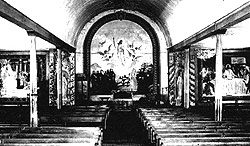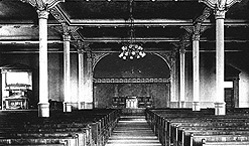|
Two:
EARLY PRISON LIFE
( excerpts )
As the 1800s progressed, construction at the prison continued. On October 31, 1830, Robert Wiltsie replaced Lynds as warden. . . .
Additional buildings, including a kitchen and hospital, were built along with a chapel for 900 men. A year later, 200 cells were added with the addition of a fifth tier. By the mid- 1850s, with the inmate population over 1,000, yet another expansion was necessary. With this expansion, the cellblock would now stand six tiers high and house more than 1,200 prisoners.
The quarrying of stone continued with inmates working in 10-hour shifts under Warden Wiltsie's supervision. Sing Sing provided stone . . . used for - the courthouse in Troy,
- City Hall in Albany, and
- Grace Church on Broadway in New York City
- Printext Building, Highland Court Apartments, and Calvary Baptist Church in Ossining . . .
. . . barges on the Hudson River provided transportation for stone being sent north to Albany or south to New York City.
In time . . . inmates began producing boots, shoes, hats, mattresses, and barrels. . . . also sold to the public . . . this practice . . . of inmate contract labor [was] eventually phased out in the late 1800s because of bitter opposition from labor unions. In 1901, the village of Sing Sing changed its name to Ossining because local merchants did not want their goods associated with merchandise from the nearby prison of the same name.
In 1837, part of the prison was partitioned off for the purpose of receiving female inmates. A separate building containing 81 cells was completed in 1839 to house the female prison population.
. . . . The women's population continued to increase, and by 1853 well over 100 women occupied the 81 cells. In 1877, the state began transferring female inmates out of Sing Sing to local jails. By November 1877, the women's cellblock . . . closed forever.
. . . . In 1900, the long-held practice of the lockstep, which involved marching the prisoners while they were shackled together at the ankles, was abolished. Similarly, the wearing of the archetypal striped prison suit was eliminated in 1904.
By 1913, inmates were permitted to remain out of their cells on Sunday for recreation and exercise. Baseball was introduced on the recreation field in 1914 under Warden [Thomas] McCormack.
Warden Thomas Mott Osborne continued this direction of prison-life reform with the introduction of the Mutual Welfare League. This was a self-governed organization among prisoners that consisted of an executive board, several delegates, and a court with seven judges. The prison administration and the league worked together to hear grievances and mutually enforce the prison rules.
| 




